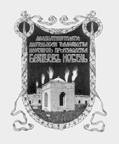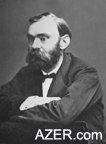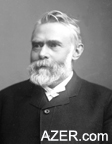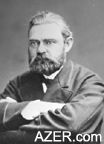|
|
 |
 |
 |
 |
Above, left to right: Logo of Nobel Brothers'Petroleum Company, depicting the Fire-Worshippers' Temple in Surakhani near their oil fields. Nobel Brothers - Alfred, Ludvig and Robert.
Other articles related to the Nobel Brothers:
(1) Nobel
Prize Funded from Baku by Adil Baghirov (AI 4:2, Summer 1996)
(2) The Nobel
Prize in Postage Stamps by Hugo Vargas (AI 4.3, Autumn 1996)
(3) Toni
Morrison's Nobel Prize Acceptance Speech, (AI 6.3, Autumn
1998)
(4) Newsmakers: Nobel
Prize Centennial by Brita Asbrink (AI 9:3, Autumn 2001)
(5) Nobels
in Baku: Swedes' Role in Baku's First Oil Boom
Nearly every park in Baku, including the famous Boulevard Park which parallels the seacoast, is artificial. Traditionally, the soils of the Absheron Peninsula on which Baku is situated, are so arid that little grows on its own. The forceful winds that whip off the sea, and for which Baku is so famous, also seriously hinder the growth of plants and trees much less the development of parks.
Even after the "Oil Boom"
of the 1870s when Baku was developing into a huge industrial
center and gaining its reputation as "Oil Capital of the
World", the city was suffering from lack of vegetation and
plant life. It was only at the end of the century that the oil
barons, working with city authorities, managed to do something
about the bleak landscape.
The "greening" of Baku was an immense and extremely
expensive undertaking. First, it required that tons and tons
of fertile earth be imported to enrichen the soil quality. To
facilitate this, Baku's Mayor, R. R. Hoven, supported by the
richest industrialists, passed a decree in the 1880s that all
ships entering Baku harbors from Iran had to bring fertile soil
with them. In reality, it was a kind of "tax" or "duty"
imposed for the right to use the harbor and load up with oil.
Needless to say, within a very short time, enough soil was deposited,
and the parks that characterize the city today were developed.
Most Magnificent Park
in Baku
The most magnificent
of all parks was the one developed by the Nobel Brothers. Located
on the border between the residential and industrial sections
of Baku, familiarly known even to this day as "White City"
and "Black City", it was here that the Nobels built
their own residence which they called Villa Petrolea and around
which they developed the park.
The story the Nobel Brothers' involvement with Azerbaijan begins
when Robert happened to pass through Baku in 1873 in search of
wood of high quality for gunstocks that they were manufacturing
in Russia. As it was too difficult and expensive to import the
wood from Europe, the young entrepreneur had come to the Caucasus
to procure walnut and various other kinds of timber from the
virgin forests in the southern region of Azerbaijan.
Enroute, he passed through Baku and witnessed the oil fever which
had just begun. Immediately, he saw the potential profitability
of oil and dared to invest all his "walnut money" to
purchase a little refinery and a kerosene-producing plant. It
took several years, however, to persuade his brother, Ludwig,
to come to Baku where in 1879 together they would establish the
Nobel Brothers' Oil Producing Company. That decision resulted
in the Nobel Brothers' presence being felt in Baku for the next
40 years during which time their company would become the largest
oil producer in the region. By 1913, for example, they were producing
more than 30 million barrels of oil per year.
The Nobels sparked a technical revolution in oil extraction,
refining and transportation. They developed the first pipelines,
first railway oil tankers, first storage tanks, and many other
firsts. Within a very short time, a new industrial suburb grew
up centering around the Nobel-owned refineries. At that time,
the view of chimneys and pipes was a symbol of progress and mankind's
achievements. No one was concerned about environment and ecology.
The oil refineries emitted such immense clouds of smoke that
travelers used to write that it was like being confined inside
a chimney. Even when you go to "Black City" today,
the thick odor of black oil hangs in the air. Sometimes it's
so strong you can taste it. The situation was much worse 100
years ago.
Consequently, it's only natural that the concept for a park would
develop. Ludwig is credited with the idea. Beginning in 1882-1883,
the Nobel Brothers began ordering all their empty ships returning
from Iran and Lankaran (the southern part of Azerbaijan) to carry
back the best fertile soils available in their holds. With this
rich earth, they began cultivating an area of more than 10 hectares
(nearly 25 acres). They even brought the well-known European
botanist, E. Bekle, who had created many of the parks and gardens
in Warsaw to Baku.
After laying in the fertile soil, Bekle began importing various
plants and trees, many from the Lankaran region, Tbilisi and
Batum (Georgia). He paid particular attention to the problems
of symbiosis and the co-existence of these plants. Rare species
were ordered from Russia and Europe. In the end, he was able
to create a huge "green ensemble" of more than 80,000
plants and trees, including many fruit trees, many of which had
never been cultivated in Baku.
But as they were nearing completion of their work, they realized
they would have to solve another serious problem. They needed
fresh water as there was none in Baku for irrigating such a large
park. Once again Ludwig proved resourceful. This time, he ordered
his tankers to return with their holds filled with fresh water
from the Volga River. Later on they devised a way from which
they could irrigate the area with condensed steam generated in
their refineries and routed to the park via special pipelines.
The investment for the park exceeded 250 thousand rubles, an
incredibly large sum at that time. It included a clubhouse ("Upper
House"), a library and residences for the many workers.
The park soon became a favorite place in the whole city.
Despite all the expenses and energy that the Nobels expended
on this "green miracle", it can't really be said that
it was a philanthropic gesture to the city. Despite their having
created a huge company, and built numerous cottages and dormitories
for their employees, the Nobel Brothers did not construct even
a single architectural monument in the center of Baku, unlike
other foreign companies such as the Rothchilds or other oil millionaires.
Simply, the Nobels created the park in an attempt to normalize
living conditions and provide a place for their engineers and
top level employees to relax.
Nevertheless, one cannot but feel somewhat nostalgic for the
times when industrialists who pursued their own personal aims
and purposes gave us a legacy of such masterpieces and miracles.
For many generations and even to this day, the older Bakuites
fondly remember the park which later came to be called Rotifane
and later Nizami (a poet) as one of the most romantic memories
of their youth.
The Future
Today there is a great wish
among many Azerbaijanis to preserve the Nobel heritage. The villa,
itself, standing in the middle of the park maintains a solid
appearance with its attractive stone façade. The inside
of the mansion has been completely gutted and left derelict in
need of serious repair.
There are dreams that one day the Residence could be rehabilitated
and transformed into a Petroleum or a Nobel Prize Museum. There
has even been some discussion about establishing an Ecological
Center there named after the Nobels committed to the elimination
of harmful effects of pollution resulting from the extraction
of oil on the Absheron Peninsula and Caspian Sea.
Fuad Akhundov is a historian enthusiast in Baku. (Deep appreciation
is extended to Shamil Fatullayev, Doctor of Architecture and
S. Alizade, Former Mayor of Baku, and the Swedish Consulate in
Los Angeles for assistance in writing this article).
The Nobel Prize
The prestigious Nobel
Prize, which is widely regarded as the highest recognition
of intellect, has links to the oil fields in Baku. The Prize
was established in 1901, from Alfred
Nobel's will after his death (1833-1896) by consolidating
the wealth from sales of explosives and from shares in the oil
fields in Baku.
Alfred was the largest single stockholder in Nobel Brothers'
Oil-Producing Company in Baku. When the prize fund was established,
Alfred's wealth was valued at 31 million Sweden crowns of which
12% was said to have come from oil. Swedish historian, E. Bargengren,
awho had access to the Nobel's family archives, insists that
it was the decision to allow withdrawal of Alfred's money that
was the "decisive factor that enabled the Nobel Prizes to
be established."
Annual prizes are given in six fields which, it is generally
agreed, are extensions of Alfred Nobel's lifelong concerns and
interests-Physics, Physiology, Chemistry, Literature and Peace.
The Economics prize was added in 1968. Announcements are made
each year in September and October. Awards are actually presented
on December 10th each year in Sweden.
From Azerbaijan International
(2.3)
Autumn 1994.
© Azerbaijan International 1994. All rights reserved.
Back
to AI 2.3 (Autumn 1994)
AI Home
| Magazine
Choice
| Topics
| Store
| Contact
us
